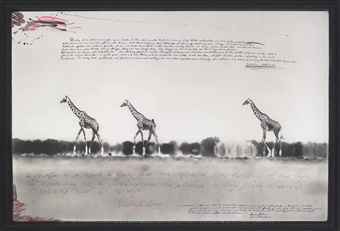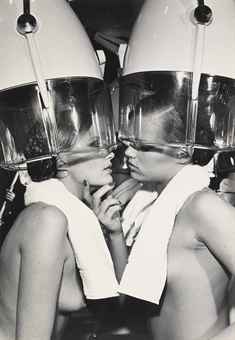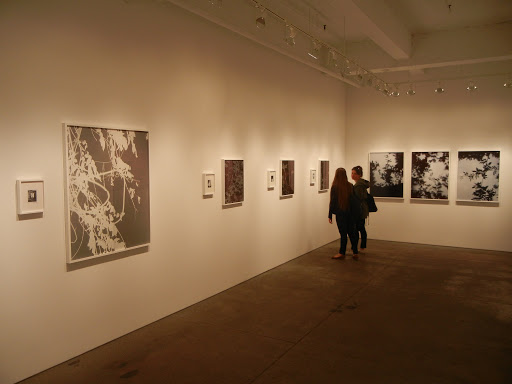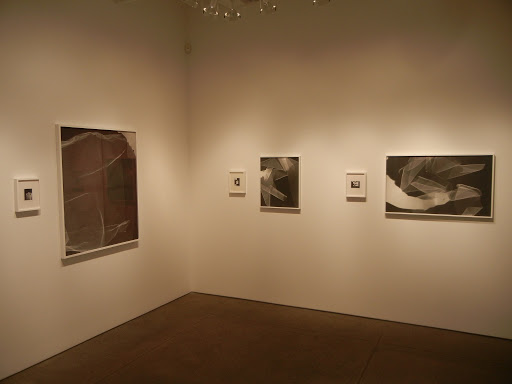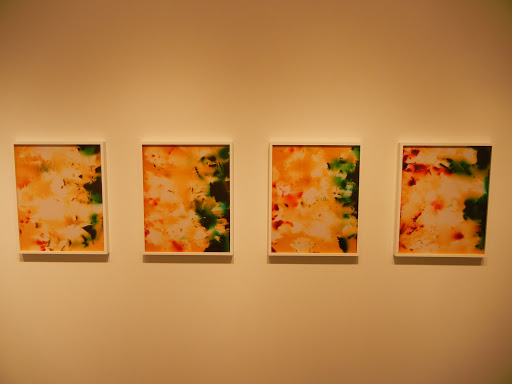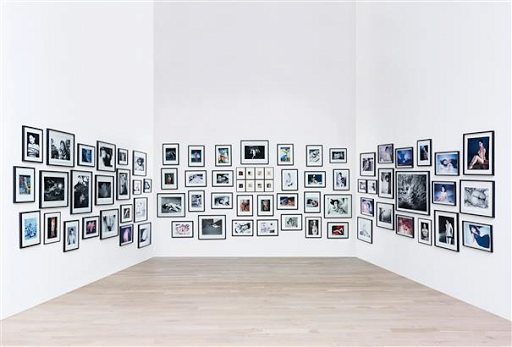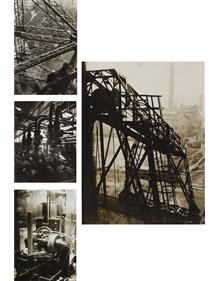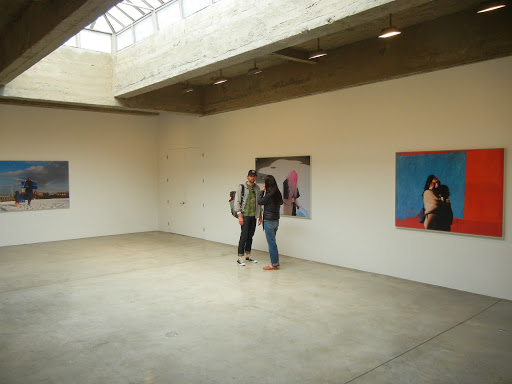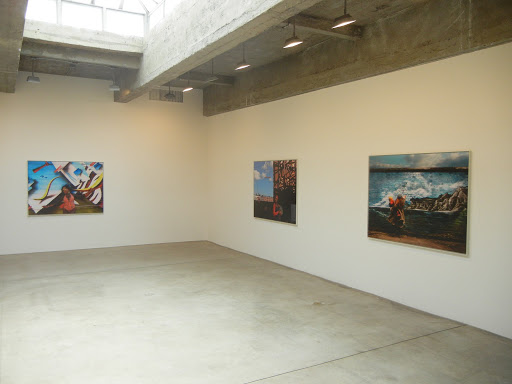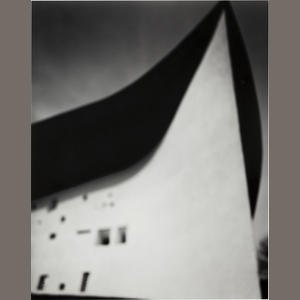 JTF (just the facts): A total of 26 color photographs, framed in white and unmatted, and hung in the entry area and the main gallery space. The show also includes 1 video piece, which is shown in the smaller side room. All of the photographs are c-prints, made in 2012. Sizes range from 10×10 to 48×48, and the prints are available in editions of 5 or 7. Two groups of photographs are hung in sets (one group of 8 and one grid of 9). The video is 6 minutes long and was made in 2012; it is available in an edition of 3. (Installation shots at right.)
JTF (just the facts): A total of 26 color photographs, framed in white and unmatted, and hung in the entry area and the main gallery space. The show also includes 1 video piece, which is shown in the smaller side room. All of the photographs are c-prints, made in 2012. Sizes range from 10×10 to 48×48, and the prints are available in editions of 5 or 7. Two groups of photographs are hung in sets (one group of 8 and one grid of 9). The video is 6 minutes long and was made in 2012; it is available in an edition of 3. (Installation shots at right.)
Comments/Context: Karine Laval has spent the better part of the last decade photographing swimming pools: their surrounding architecture, the way people interact with them, and particularly the shifting effects of light on the surface of the water. Her newest works stay true to her chosen subject matter, but move further toward distortion, with a stronger emphasis on movement. The results are ethereal and painterly, and often nearly abstract.
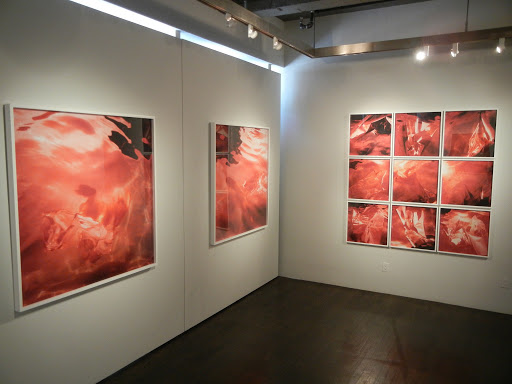 Laval’s Collision series is the most visually innovative of the projects on view. Starting with large sheets of shiny mylar paper, she has submerged them in the water, allowing them to bend and crinkle as they float underneath the surface. Light glances and refracts off the paper, interacting with the already distorted shimmer of the pool itself, creating blasts of complex pattern in bold transparent red. They reminded me of the way light bounces off a John Chamberlain sculpture or the crumpled surfaces of Nicolai Howalt’s car crash studies. I like the depth of space she has created, allowing foreground and background to mix into one swirling explosion of lush color.
Laval’s Collision series is the most visually innovative of the projects on view. Starting with large sheets of shiny mylar paper, she has submerged them in the water, allowing them to bend and crinkle as they float underneath the surface. Light glances and refracts off the paper, interacting with the already distorted shimmer of the pool itself, creating blasts of complex pattern in bold transparent red. They reminded me of the way light bounces off a John Chamberlain sculpture or the crumpled surfaces of Nicolai Howalt’s car crash studies. I like the depth of space she has created, allowing foreground and background to mix into one swirling explosion of lush color.
 Her Flux series (and the accompanying State of Flux video) introduces a more performative aspect to her work. In addition to the loosely floating mylar sheet, a male dancer in what looks to be a mylar set of swimming trunks dives and whirls through the water. He becomes a kind of fleeting blur offset by the bright shininess of the mylar, disrupting the calm flow and adding balletic spins, splits, and somersaults. His ghostly figure moves with purpose, only to disappear into the shifting hues of pink and blue and the jagged reflections from above. Her Echo series plays with multiple reflections of silhouettes, distorted by the proportions of the pool like Kertesz and his fun house mirror nudes. Standing subjects become strange totemic forms with bulging bodies and elongated arms, doubled into gesticulating conversation with themselves.
Her Flux series (and the accompanying State of Flux video) introduces a more performative aspect to her work. In addition to the loosely floating mylar sheet, a male dancer in what looks to be a mylar set of swimming trunks dives and whirls through the water. He becomes a kind of fleeting blur offset by the bright shininess of the mylar, disrupting the calm flow and adding balletic spins, splits, and somersaults. His ghostly figure moves with purpose, only to disappear into the shifting hues of pink and blue and the jagged reflections from above. Her Echo series plays with multiple reflections of silhouettes, distorted by the proportions of the pool like Kertesz and his fun house mirror nudes. Standing subjects become strange totemic forms with bulging bodies and elongated arms, doubled into gesticulating conversation with themselves.
Overall, I think this new work is less literal and more diaphanous than her previous efforts, willing to explore the edges of the illusory and the immaterial with more abandon. The more she walks the line of unrecognizable abstraction, the more challenging the work becomes.
 Collector’s POV: The prints in this show are priced as follows, based on size: 10×10 ($2200), 20×20 ($3500), 30×30 ($5500), and 48×48 ($9500). The two sets are $15000 (group of 8) and $28000 (grid of 9) respectively. Laval’s work has not yet reached the secondary markets with any regularity, so gallery retail remains the best/only option for those collectors interested in following up.
Collector’s POV: The prints in this show are priced as follows, based on size: 10×10 ($2200), 20×20 ($3500), 30×30 ($5500), and 48×48 ($9500). The two sets are $15000 (group of 8) and $28000 (grid of 9) respectively. Laval’s work has not yet reached the secondary markets with any regularity, so gallery retail remains the best/only option for those collectors interested in following up.
